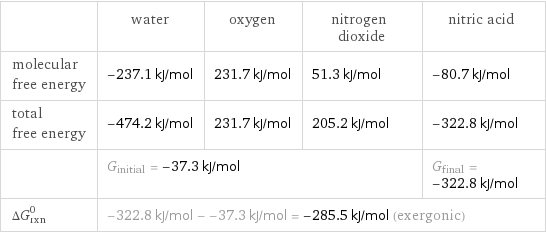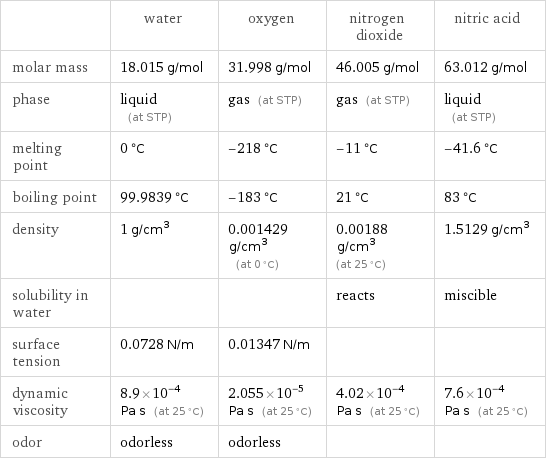Input interpretation

H_2O (water) + O_2 (oxygen) + NO_2 (nitrogen dioxide) ⟶ HNO_3 (nitric acid)
Balanced equation

Balance the chemical equation algebraically: H_2O + O_2 + NO_2 ⟶ HNO_3 Add stoichiometric coefficients, c_i, to the reactants and products: c_1 H_2O + c_2 O_2 + c_3 NO_2 ⟶ c_4 HNO_3 Set the number of atoms in the reactants equal to the number of atoms in the products for H, O and N: H: | 2 c_1 = c_4 O: | c_1 + 2 c_2 + 2 c_3 = 3 c_4 N: | c_3 = c_4 Since the coefficients are relative quantities and underdetermined, choose a coefficient to set arbitrarily. To keep the coefficients small, the arbitrary value is ordinarily one. For instance, set c_2 = 1 and solve the system of equations for the remaining coefficients: c_1 = 2 c_2 = 1 c_3 = 4 c_4 = 4 Substitute the coefficients into the chemical reaction to obtain the balanced equation: Answer: | | 2 H_2O + O_2 + 4 NO_2 ⟶ 4 HNO_3
Structures

+ + ⟶
Names

water + oxygen + nitrogen dioxide ⟶ nitric acid
Reaction thermodynamics
Gibbs free energy

| water | oxygen | nitrogen dioxide | nitric acid molecular free energy | -237.1 kJ/mol | 231.7 kJ/mol | 51.3 kJ/mol | -80.7 kJ/mol total free energy | -474.2 kJ/mol | 231.7 kJ/mol | 205.2 kJ/mol | -322.8 kJ/mol | G_initial = -37.3 kJ/mol | | | G_final = -322.8 kJ/mol ΔG_rxn^0 | -322.8 kJ/mol - -37.3 kJ/mol = -285.5 kJ/mol (exergonic) | | |
Entropy

| water | oxygen | nitrogen dioxide | nitric acid molecular entropy | 69.91 J/(mol K) | 205 J/(mol K) | 240 J/(mol K) | 156 J/(mol K) total entropy | 139.8 J/(mol K) | 205 J/(mol K) | 960 J/(mol K) | 624 J/(mol K) | S_initial = 1305 J/(mol K) | | | S_final = 624 J/(mol K) ΔS_rxn^0 | 624 J/(mol K) - 1305 J/(mol K) = -680.8 J/(mol K) (exoentropic) | | |
Equilibrium constant
![Construct the equilibrium constant, K, expression for: H_2O + O_2 + NO_2 ⟶ HNO_3 Plan: • Balance the chemical equation. • Determine the stoichiometric numbers. • Assemble the activity expression for each chemical species. • Use the activity expressions to build the equilibrium constant expression. Write the balanced chemical equation: 2 H_2O + O_2 + 4 NO_2 ⟶ 4 HNO_3 Assign stoichiometric numbers, ν_i, using the stoichiometric coefficients, c_i, from the balanced chemical equation in the following manner: ν_i = -c_i for reactants and ν_i = c_i for products: chemical species | c_i | ν_i H_2O | 2 | -2 O_2 | 1 | -1 NO_2 | 4 | -4 HNO_3 | 4 | 4 Assemble the activity expressions accounting for the state of matter and ν_i: chemical species | c_i | ν_i | activity expression H_2O | 2 | -2 | ([H2O])^(-2) O_2 | 1 | -1 | ([O2])^(-1) NO_2 | 4 | -4 | ([NO2])^(-4) HNO_3 | 4 | 4 | ([HNO3])^4 The equilibrium constant symbol in the concentration basis is: K_c Mulitply the activity expressions to arrive at the K_c expression: Answer: | | K_c = ([H2O])^(-2) ([O2])^(-1) ([NO2])^(-4) ([HNO3])^4 = ([HNO3])^4/(([H2O])^2 [O2] ([NO2])^4)](../image_source/66693640269fb917afbc047f4a277f1f.png)
Construct the equilibrium constant, K, expression for: H_2O + O_2 + NO_2 ⟶ HNO_3 Plan: • Balance the chemical equation. • Determine the stoichiometric numbers. • Assemble the activity expression for each chemical species. • Use the activity expressions to build the equilibrium constant expression. Write the balanced chemical equation: 2 H_2O + O_2 + 4 NO_2 ⟶ 4 HNO_3 Assign stoichiometric numbers, ν_i, using the stoichiometric coefficients, c_i, from the balanced chemical equation in the following manner: ν_i = -c_i for reactants and ν_i = c_i for products: chemical species | c_i | ν_i H_2O | 2 | -2 O_2 | 1 | -1 NO_2 | 4 | -4 HNO_3 | 4 | 4 Assemble the activity expressions accounting for the state of matter and ν_i: chemical species | c_i | ν_i | activity expression H_2O | 2 | -2 | ([H2O])^(-2) O_2 | 1 | -1 | ([O2])^(-1) NO_2 | 4 | -4 | ([NO2])^(-4) HNO_3 | 4 | 4 | ([HNO3])^4 The equilibrium constant symbol in the concentration basis is: K_c Mulitply the activity expressions to arrive at the K_c expression: Answer: | | K_c = ([H2O])^(-2) ([O2])^(-1) ([NO2])^(-4) ([HNO3])^4 = ([HNO3])^4/(([H2O])^2 [O2] ([NO2])^4)
Rate of reaction
![Construct the rate of reaction expression for: H_2O + O_2 + NO_2 ⟶ HNO_3 Plan: • Balance the chemical equation. • Determine the stoichiometric numbers. • Assemble the rate term for each chemical species. • Write the rate of reaction expression. Write the balanced chemical equation: 2 H_2O + O_2 + 4 NO_2 ⟶ 4 HNO_3 Assign stoichiometric numbers, ν_i, using the stoichiometric coefficients, c_i, from the balanced chemical equation in the following manner: ν_i = -c_i for reactants and ν_i = c_i for products: chemical species | c_i | ν_i H_2O | 2 | -2 O_2 | 1 | -1 NO_2 | 4 | -4 HNO_3 | 4 | 4 The rate term for each chemical species, B_i, is 1/ν_i(Δ[B_i])/(Δt) where [B_i] is the amount concentration and t is time: chemical species | c_i | ν_i | rate term H_2O | 2 | -2 | -1/2 (Δ[H2O])/(Δt) O_2 | 1 | -1 | -(Δ[O2])/(Δt) NO_2 | 4 | -4 | -1/4 (Δ[NO2])/(Δt) HNO_3 | 4 | 4 | 1/4 (Δ[HNO3])/(Δt) (for infinitesimal rate of change, replace Δ with d) Set the rate terms equal to each other to arrive at the rate expression: Answer: | | rate = -1/2 (Δ[H2O])/(Δt) = -(Δ[O2])/(Δt) = -1/4 (Δ[NO2])/(Δt) = 1/4 (Δ[HNO3])/(Δt) (assuming constant volume and no accumulation of intermediates or side products)](../image_source/fd9625a9404398cd85526d778c31f293.png)
Construct the rate of reaction expression for: H_2O + O_2 + NO_2 ⟶ HNO_3 Plan: • Balance the chemical equation. • Determine the stoichiometric numbers. • Assemble the rate term for each chemical species. • Write the rate of reaction expression. Write the balanced chemical equation: 2 H_2O + O_2 + 4 NO_2 ⟶ 4 HNO_3 Assign stoichiometric numbers, ν_i, using the stoichiometric coefficients, c_i, from the balanced chemical equation in the following manner: ν_i = -c_i for reactants and ν_i = c_i for products: chemical species | c_i | ν_i H_2O | 2 | -2 O_2 | 1 | -1 NO_2 | 4 | -4 HNO_3 | 4 | 4 The rate term for each chemical species, B_i, is 1/ν_i(Δ[B_i])/(Δt) where [B_i] is the amount concentration and t is time: chemical species | c_i | ν_i | rate term H_2O | 2 | -2 | -1/2 (Δ[H2O])/(Δt) O_2 | 1 | -1 | -(Δ[O2])/(Δt) NO_2 | 4 | -4 | -1/4 (Δ[NO2])/(Δt) HNO_3 | 4 | 4 | 1/4 (Δ[HNO3])/(Δt) (for infinitesimal rate of change, replace Δ with d) Set the rate terms equal to each other to arrive at the rate expression: Answer: | | rate = -1/2 (Δ[H2O])/(Δt) = -(Δ[O2])/(Δt) = -1/4 (Δ[NO2])/(Δt) = 1/4 (Δ[HNO3])/(Δt) (assuming constant volume and no accumulation of intermediates or side products)
Chemical names and formulas

| water | oxygen | nitrogen dioxide | nitric acid formula | H_2O | O_2 | NO_2 | HNO_3 name | water | oxygen | nitrogen dioxide | nitric acid IUPAC name | water | molecular oxygen | Nitrogen dioxide | nitric acid
Substance properties

| water | oxygen | nitrogen dioxide | nitric acid molar mass | 18.015 g/mol | 31.998 g/mol | 46.005 g/mol | 63.012 g/mol phase | liquid (at STP) | gas (at STP) | gas (at STP) | liquid (at STP) melting point | 0 °C | -218 °C | -11 °C | -41.6 °C boiling point | 99.9839 °C | -183 °C | 21 °C | 83 °C density | 1 g/cm^3 | 0.001429 g/cm^3 (at 0 °C) | 0.00188 g/cm^3 (at 25 °C) | 1.5129 g/cm^3 solubility in water | | | reacts | miscible surface tension | 0.0728 N/m | 0.01347 N/m | | dynamic viscosity | 8.9×10^-4 Pa s (at 25 °C) | 2.055×10^-5 Pa s (at 25 °C) | 4.02×10^-4 Pa s (at 25 °C) | 7.6×10^-4 Pa s (at 25 °C) odor | odorless | odorless | |
Units
